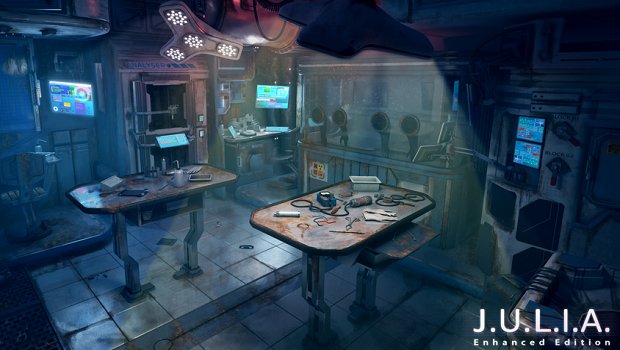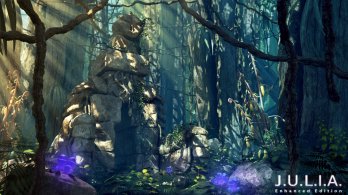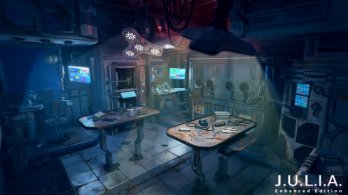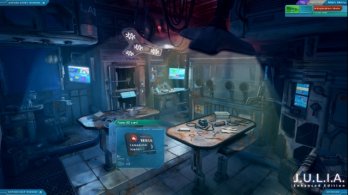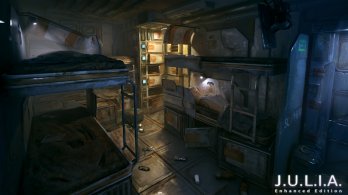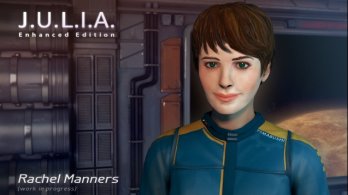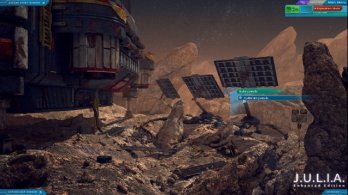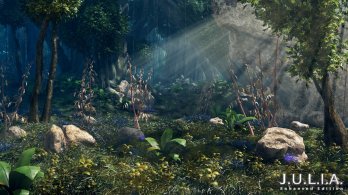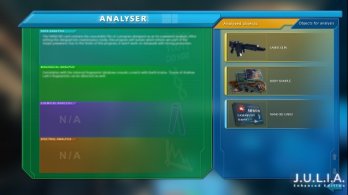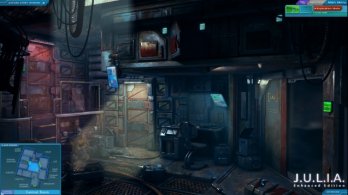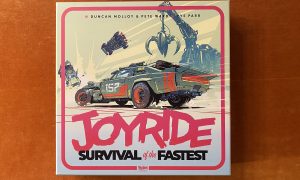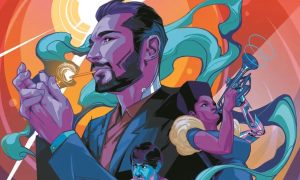 You could be forgiven if you haven’t heard of J.U.L.I.A. Although the game got good feedback from players, a limited budget and issues with the title’s publisher withholding royalty payments prevented it from taking off like the developers, CBE Software, had hoped. They were one of several developers who struggled with a lack of response and payment from UK publisher Lace Mamba. But thanks to a successful campaign on IndieGoGo, CBE Software is now back on their feet and working on a new release: J.U.L.I.A. Enhanced Edition. The new game, now on Steam Greenlight, is such an improvement over the original release of J.U.L.I.A. that they are even considering a new name for the title. I had the chance to chat with Jan Kavan, one half of CBE Software, about how they got to this point.
You could be forgiven if you haven’t heard of J.U.L.I.A. Although the game got good feedback from players, a limited budget and issues with the title’s publisher withholding royalty payments prevented it from taking off like the developers, CBE Software, had hoped. They were one of several developers who struggled with a lack of response and payment from UK publisher Lace Mamba. But thanks to a successful campaign on IndieGoGo, CBE Software is now back on their feet and working on a new release: J.U.L.I.A. Enhanced Edition. The new game, now on Steam Greenlight, is such an improvement over the original release of J.U.L.I.A. that they are even considering a new name for the title. I had the chance to chat with Jan Kavan, one half of CBE Software, about how they got to this point.
GT: How would you describe the original J.U.L.I.A to someone who has never heard of the game?
[singlepic id=16342 w=320 h=240 float=left]Kavan: The original J.U.L.I.A. was a mixture between an interface-based game in a style of “Choose your own adventure” (Snatcher comes to mind) and a puzzle game. The strong point was a heavy impact on narration and the overall plot in general. The story was centered on Rachel Manners, 35 year-old astrobiologist, who travels through the solar system of Salia in search of alien civilization and the sad fate of the rest of the expedition. Using a huge mobile robot (Mobot), Rachel is even able to explore hazardous environments without risking her life. I was careful not to portray any situations in black/white but rather from the perspective of an individual protagonist bringing many shades of what is good or evil in the mix.
Another aspect which influenced the original game was a non-existent budget. We’re just two people, who worked in our free time during the four years of the production. For that reason the production values weren’t particularly high. Still, the game was appreciated by the reviewers who understood our position and I am really proud of that achievement.
GT: What are the biggest differences between the original game and the new Enhanced Edition?
[singlepic id=16343 w=320 h=240 float=right]Kavan: Bluntly said, it’s an entirely different game. It shares with the original game just a few puzzles and a basic story skeleton. We are even currently looking for a different name, as the Enhanced Edition doesn’t reflect our new game at all; our new game features over 60% new content and basically leaves the concept of choose-your-own-adventure behind. Instead the game is reminiscent of adventure games while putting an emphasis on an interface based control. In each highly detailed and animated scene you control Mobot by choosing a proper action from a contextual action menu. The contextual menus are dynamic and contain options based upon your knowledge.
In addition to this brand new gameplay style, we now have many other gameplay devices: station computers with individual profiles and conversations of the expedition members, datapads containing logs of crew members, an ingenious analytics computer which you utilize to analyze gathered samples for vital or non-vital clues just to name a few.
[singlepic id=16355 w=320 h=240 float=right]Another big addition is a log book which tracks your progress and keeps you motivated as there will never be a point that you won’t know what to do. You might not know HOW to do it, but unlike in the original game you won’t ever be wondering: “Which planet do I need to visit in order to progress further?”
To make the game even more fun, we’ve now added a lot of optional content (or sidequests if you will). They enrich your experience and detail the world and the story while not artificially hindering your progress. This way the observant players will get much more from the game and the story. Players can now customize their experience to their liking.
GT: Were you inspired by any other games when developing J.U.L.I.A.?
Kavan: I was inspired by old games like the aforementioned Snatcher or the beautiful A Mind Forever Voyaging, but mostly for the atmosphere. J.U.L.I.A. was more a game I wanted to play myself and couldn’t find anywhere else so I had to make it.
GT: What challenges have you faced in the process of developing the game?
Kavan: There were quite a few, especially connected with finding the game identity and operating without any budget. Also living in a non-English speaking country provides for an extra layer of challenge especially when it comes to voiceover recording.
[singlepic id=16346 w=320 h=240 float=left]But basically the most challenging was to gather my energy and start over when we realized that our first iteration of the game was not fun. Back then (it was 2008), I decided to throw everything in the trash can and start over. Of course the biggest challenge then was the well-known post-release problems with our publishers. That was exactly the point when I wanted to slam the industry door shut and never look back.
GT: Unlike most games, J.U.L.I.A. stars a female protagonist. What went into this decision, and do you have any concerns about it deterring potential players?
Kavan: Not only female protagonist but also an absolutely non-stereotyped one! Our Rachel doesn’t do Taekwondo, nor she can hack computers. Even more – she is properly dressed for the whole duration of the game. You would say it’s a recipe for a commercial disaster, don’t you think?
[singlepic id=16350 w=320 h=240 float=right]She’s very specialized astrobiologist and the technology she has to manipulate was not meant for her but rather for her more technology-savvy colleagues. This brings in an extra level of challenge for her, as she has to overcome her narrow-minded approach. There’s no one to help her out. However, she is rewarded by getting her dream come true. From meeting extraterrestrials to exploring new worlds, who would not sacrifice their fears to experience that? J.U.L.I.A. is by no means an epic game but rather a very intimate story about fears and very personal questions of what is acceptable, what is good or wrong, and how to cope with that.
GT: What else distinguishes J.U.L.I.A. Enhanced Edition from other adventure games we’ve seen in recent years?
Kavan: First of all, the interface based adventure game is not very common. Unless you count Experiment 112, you don’t usually see those. Even then, J.U.L.I.A. is very original in execution. Technology-wise the game runs at Full HD or HD ready resolutions bringing alive extremely detailed environments. Add in all the new gameplay devices I’ve already mentioned and you already get something quite new.
[singlepic id=16354 w=320 h=240 float=left]However there’s another thing which sets the game apart from many games in the industry. J.U.L.I.A. Enhanced Edition has my own invention of procedurally generated interactive music. This means that the music is composed in real time and reacts to your actions in the game. Especially when you explore the deserted research stations or deep jungle, you never get that repetitive feel of many games nowadays. Instead the game can intensify the music when needed without any sharp cuts or something trivial like layering.
The funny thing is that I lectured about this theoretical concept at the Musica Nova conference in 2012 and now I have a proof that it can be done and moreover it sounds great!
GT: Can you describe some of the technology players will interact with in the game, such as the MOBOT?
[singlepic id=16345 w=320 h=240 float=right]Kavan: The game is split in two parts. In the probe view you travel among various planets, scan them, upgrade or repair the probe or Mobot and solve some of the puzzles. The major part, however, is upon landing on the individual planets where you see the environment through the eyes of Mobot himself, who has detachable head for tight-space exploration. Most of the gameplay is then seen through the cameras of Mobot.
I’ve already mentioned the technology new to J.U.L.I.A. Enhanced Edition. Basically the devices you operate are extremely user friendly and I am trying to place the challenge on the contents, and not on the controls.
As a separate chapter there are puzzle interfaces which are very contextual to the environment and I am trying to make all the puzzles integral parts of the story and reasonable in the context. One example is datapad password hacking. For example, a crew leader would use password in a form of an unintelligible alphanumeric combination and secured by strong cryptography (you have to find that password somehow) while some of the scientists would just use some easily hackable word.
GT: Unlike the original, J.U.L.I.A. Enhanced Edition features optional side quests and missions. How much does completing these optional tasks add to the game?
[singlepic id=16349 w=320 h=240 float=right]Kavan: I’ve briefly touched these elements already, but let me make an analogy. If two persons were in the same room witnessing a sudden strange event, the more observant one would understand more what was going on while the other might just barely scratch the surface. I am prepared for the fact that some of the players will end up finishing the game and won’t understand the story completely while those who complete everything will be rewarded with fully understanding everything which has happened. The game itself helps you out by tracking your progress and telling you how thorough you have been.
GT: The Enhanced Edition also introduces new interface features, specifically the mind map and the mission log. What role do these play in the game?
Kavan: The mind’o’matic interface is helping you sort through your thoughts. You basically piece together the specific event from fragments and ruling out the wrong leads. When you finish it, the game confirms to you that you really understand the story. Again – this is an entirely optional part of the game.
Mission log is there basically for keeping you motivated. Since you see your current goals and all the tasks you already finished to reach the goal, you can return to the game even after some period of non-playing and you will be quickly able to jump in.
GT: What kind of feedback has J.U.L.I.A. Enhanced Edition gotten so far?
[singlepic id=16351 w=320 h=240 float=left]Kavan: We’re amazed by the incredibly supportive reaction to every single released asset. We’ve won screenshot of the day two times over at gamedev.net, the press and our backers are happy with the progress, and overall we really feel that this time the production values went so high that they support the original vision. We are still mere two-man indie team but since we’ve reached almost three times more money than asked for in our IndieGoGo campaign, we can do things we haven’t been able to before!
GT: Is there anything else you’d like to share that might convince readers to try the game?
Kavan: Let’s start with this exclusive screenshot. It’s something we are working on right now.

We also have a teaser trailer and our Steam Greenlight campaign. Getting on Steam for us is a question of continuation so if you can support us by an upvote, please do so! Another thing is that I’m currently writing a blog about our experience with crowdfunding and sharing some tips and views how we’ve achieved what we did. You can find it here and it may bring an additional human level to a game development. It really is a difference if you have a team of 50 people operating on a multimillion budget or if you have two indies working with $14k. On closing I would like to thank you very much for your great and original questions. I had a great time answering them and I strongly believe our new game will be well worth the wait until the end of Q1/2014 when we currently plan to release the game.
Breanna has been gaming since infancy, if gnawing on an unattended controller counts as playing a game. One of the younger members of the Gaming Trend family, she dabbled in PC games as a kid but wasn't fully consumed by the hobby until the sixth generation of consoles. Now an avid PC and console gamer, she looks forward to the day when she can scape together enough cash to join the next gen club.
In the last week of middle school, a math teacher taught her how to program a calculator; she was pretty much hooked then and there. Currently working towards a degree in Computer Science and Applied Math, Breanna hope to someday make games instead of just writing about them. Other hobbies include playing guitar, binge-watching Netflix, and cooking delicious food.

See below for our list of partners and affiliates:
